This is a full guide on how to choose the best pizza peels for transferring your homemade pizzas. Pizza peels vary by functions, materials, and surfaces. So, keep reading to see how to choose the one that fits your need. Also, see our article on “Homemade Pizzas in the Oven Guide” and our category of other Food Equipment & Tools.
What are Pizza Peels?
Pizza Peels or pizza paddles are baking tools with handles used to move a cooked or uncooked pizza. They have different functions, materials, and platform surfaces. Some pizza peels can transfer a raw, prepped pizza from a work surface into the oven. And some can transfer a baked pizza out of the oven. They designed others just to turn a pizza around while remaining baking in the oven. Keep reading to see how to choose the best pizza peels for your personal needs.
We’ll stay with the term “pizza peel”; however, here are other names of this tool.
- Pizza Spatula
- Pizza Scoop
- Food Shovel or Pizza Shovel
Also, we’ll often use the term “transferring” a pizza. That’s for referring to moving, scooping, or shoveling a pizza from one location to another.
Is a Pizza Peel Necessary?
A pizza peel is necessary if you’re wanting to make the work of homemade pizzas easier and successful. A peel is also absolutely necessary if you’re wanting to improve the flavor of your pizzas by cooking them on a pizza stone or pizza steel, or in a pizza oven.
Do you need a pizza peel?
When you want to bake better pizzas on a pizza stone or pizza steel, you’ll need a pizza peel. When making a pizza to go directly onto a hot cooking surface, you’ll be preparing it directly on a work surface like a countertop. From there, you cannot manually pickup the fully prepared raw pizza dough with toppings, and then place it onto any pizza baking surface. It will sag and nearly all the toppings will have fallen off. Thus, the need for a tool that transfers pizzas is required.
Here are some examples that I use certain types of pizza peels for:
- get a pizza from off a countertop
- to remove a pizza from a cooking surface in an oven
- remove a pizza from or insert onto the cooking surface in an oven
If you want to learn more on usage of pizza peels, read our article on how to use a pizza peel.
Not all types of pizza peels can do all things you might want one to do. So, that leads us into the next topic of what to look for in a pizza peel.
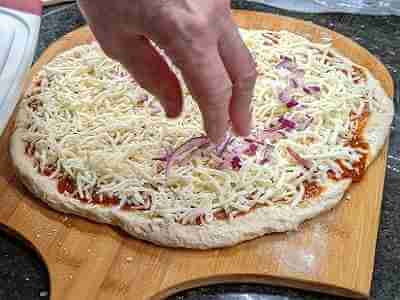
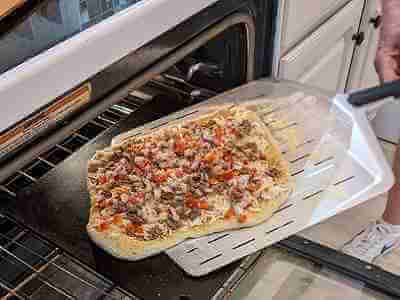
What Is The Best Pizza Peel by Function, Type, and Material?
If you’re considering or are already making pizza at home, you want to know what is the best pizza peel. You might look for one based on function, type, and material. You’ll see easily what to look for and what we’ve selected for usage and why. We’ve worked in management in several restaurants in several states. So, we understand pizza needs in the kitchen.
What to Look for in a Pizza Peel
You’ll want to consider the following attributes for a peel. And you will choose each based on what specific functions you want it to perform in your individual home environment.
- Material: Wood or Metal
- Handle Length
- Surface: Solid, holes, slits, channels, thin or thick, and beveled or not beveled
If you want to see some visual ideas of making pizzas using different types of pizza peels, here’s a good article. Here’s a complete list of pizza recipes and steps of how to make homemade pizzas in the “Homemade Pizzas in the Oven” Guide.
Keep reading to learn of all those aspects of what you might want. They all depend on how you make your pizzas, your kitchen environment, and what you’re using to cook on.
1. Wooden Pizza Peel vs Metal
A pizza peel material is usually wood or metal. There are recent additions of composite materials too. It has a long, flat surface (paddle). You can dust the surface with flour or cornmeal to prevent the pizza from sticking. Composites are easier to clean and often quite durable.
There are some that I have seen reviewers comment about “chunks” or “chips” that have broken off after some extensive usage so, the jury’s still out on this material. However, if I was going to ever consider one, with what I have seen from many reviewers, I would choose the Epicurean Pizza Peel that is a composite. It seems to be a very good one to look into.
Is A Woodend Pizza Peel Better Than A Metal Pizza Peel?
When asking “is a wood or metal pizza peel better?”, that’s a very smart question, and the answer is they both are best. If you cook a lot of pizzas, calzones, and breads, you may want one of each. But you can comfortably begin with just one, as I did.
Metal peels can be more durable and less likely to stick, but you can use wooden peels for cutting or serving the pizza slices on directly. Read further to really get into the pros and cons between the wood and metal pizza peels. It will help you decide.
What’s the Difference Between Wood and Metal Pizza Peels?
Wood and metal pizza peels are both tools used to place a pizza in the oven. A metal peel is a thin, flat piece of metal with a handle used to slide the pizza into the oven. A wooden peel is a thicker, more sturdy piece of wood with a handle that is also used to slide the pizza into the oven. Both peels have their own benefits and drawbacks.
Pizza Peels Wooden
Wooden pizza peels will need to have a good beveled edge for using to remove a pizza from the oven. Wooden peels aren’t good for scooping up raw dough pizzas because there’s a limit to the thinness of the beveled edge. However, some will drag their pizza without toppings onto a wooden peel and then top it from there. That avoids the need for scooping it off from the work surface.
However, if you take too long to top the pizza, moisture tends to creep into the wooden paddle and then starts to stick. So, the workaround for that is to “shake” the pizza dough during the topping process once a minute to ensure it’s not sticking.
Metal Pizza Peels
A metal peel is more lightweight and easier to maneuver than a wood peel. However, because it is thinner, it can be more difficult to slide the pizza into the oven without dropping it. A wood peel is thicker and more sturdy, making it less likely to bend or break when sliding the pizza into the oven. However, because it is thicker, it can be more difficult to maneuver than a metal peel.
Metal peels will be great for keeping an uncooked pizza from sticking to the work surface. And, the concept of being metal itself will avoid the absorption of moisture, which is a key issue of wooden peels for sticking. The metal peels will have a very thin edge and the better ones will also have a slightly beveled edge as well.
Some prefer to use a metal peel because it is lighter and easier to handle. Others prefer to use a wooden peel because it is more sturdy, less likely to bend or break, and you can cut the pizza slices on it. Wooden peels require the raw pizza (topped or not topped) to be drug onto it since it can’t “scoop” up the pizza from the work surface.
Deciding on Wood vs Metal Pizza Peels
Finally, think about how often you’ll be making pizzas, calzones, and other related bakery products. If you’re making pizza occasionally, either a metal or wooden peel should suffice. But, whether you’re making pizzas in your everyday oven or using a pizza oven regularly, invest in a good metal lightweight peel that works specifically designed for that purpose.
Ultimately, it is up to the individual cook to decide which type of peel they prefer to use. And, if you’re wanting to truly improve your experiences overall, you’ll actually want to have two peels, one metal and one wooden. Don’t forget, you can cut or serve the slices of a pizza on some wooden peels, but the metal peel is better for transferring.
Best Metal for Pizza Peel
Regarding the best metal for a pizza peel, the preferred is aluminum, as it’s lighter. You’ll appreciate the lighter aluminum peel when you transfer a fully topped large, heavy pizza. Some are still avoiding the composite peels for home but I will look at in the future as they improve in durability and longer life.
There are definite uses for both wooden and metal peels. You might want to consider a metal peel but also have a wooden one.
Best Wood for Pizza Peel
The best wood for a pizza peel gives you several choices. Wooden pizza peels existed for centuries. Only in recent decades, metal pizza peels appeared. It’s durable, can withstand high temperatures, doesn’t react with food, and is biodegradable. The material that’s best is routinely debatable, but currently, see the top preferences here.
- Maple
- Bamboo
- Acacia
- Beech
What else is there to look for in selecting a pizza peel? Read further to learn more.
2. Consider the Handle Length
In choosing a peel, consider if you want a pizza peel long handle or not. While the longer handles appear in pictures as “cool”, they’re for the purpose, usually for the hotter, specific pizza ovens. Choose a handle length that will work best for you and your cooking environment. You’ll want a peel with a long enough handle to reach the back of your oven, but not so long that it’s too difficult to control and you’re hitting against cabinets or items on the countertop work surface. My handles in my kitchen peels are short and are about a foot long.
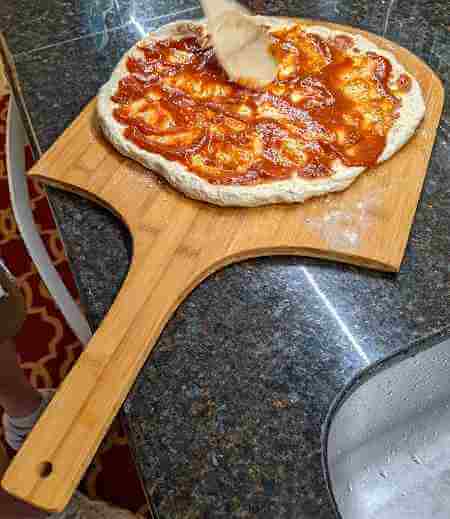
Since the handle can vary in length, you want it just long enough to handle raw pizza dough as well as a hot pizza. A short handle is about 12-inches long and a medium long handle is about 18-24-inches in length. There are some that are longer but those are generally for commercial kitchens where the volume of pizzas is high and the distances from the work surface to the ovens is much further apart.
Sometimes a peel with a long handle is beneficial for inserting the pizza(s) into a deeper hot oven that might hold several pizzas at once. Regardless of the length, you will need to adjust how you work in positioning the handle on the work surface, during pizza transfers, and in storage.
3. The Pizza Peel’s Surface – The Scooping Part
The pizza peel surface is what will hold the pizza when you scoop it up. Sometimes, you’ll be scooping up a raw dough pizza and the other times will be for the cooking or cooked pizza. With that said, the peel’s surface plays a crucial role in your selection process. There are a lot of factors to consider on surface selection so, this is the longest section to review.
Difference between a Pizza Peel and a Pizza Paddle
Technically, a pizza paddle is a little different from a pizza peel, in that a pizza paddle is heavily involved with loading items frequently in and out of the ovens. It’s also good for scraping the oven stone (or steel) layer to keep it somewhat clean.
The pizza peel can’t handle a large load like a pan pizza in an oven and it isn’t used to scrape off foods from the pizza oven’s stone. The peel is designed for lighter, routine work that is best for moving pizzas from a countertop into and then out of the oven.
There are some similar functions shared between a peel and a paddle that both can do. The term “pizza paddle” however, is used sometimes even in professional circles as referencing a peel but the real pros know the difference.
Pizza Peel Perforated or Not Perforated?
When deciding if you want a pizza peel perforated or not, understand that this will result in being a metal surface. So, in deciding further, read the next few sections to see what the benefits are with different types of perforations that are available. Also, some types of perforations will cost more than others.
Are Perforated Peels Better?
Perforated peels are significantly better but there’s one more aspect to also look for. There are 2 key aspects to the metal peels that are desired. You’ll want some opened slits (perforations) across the surface and you’ll want some raised “channels” of the surface. Keep reading on the details desired on each of these.
Peels with Slits – not Just Holes
Having slits (not just a bunch of holes) will allow 2 things that mere holes cannot do. With slits, more cornmeal and flour can fall through. Also, slits means there is less surface contact with the raw pizza dough when you’re transferring it. Finally, holes will have a tendency to get caught during the transferring scooping action; slits allow more flexible movement of the dough during the quick move action.
Peels with Raised Channels – an Added Benefit
Regarding having some raised channel portions on its surface, this helps the peel reduce sticking due to having less surface availability to have full contact. In other words, the pizza dough won’t be completely flat on the peel’s paddle surface so it reduces the possibility of sticking. This is another reason you won’t want a peel that uses an entirely flat surface, even if it has slits.
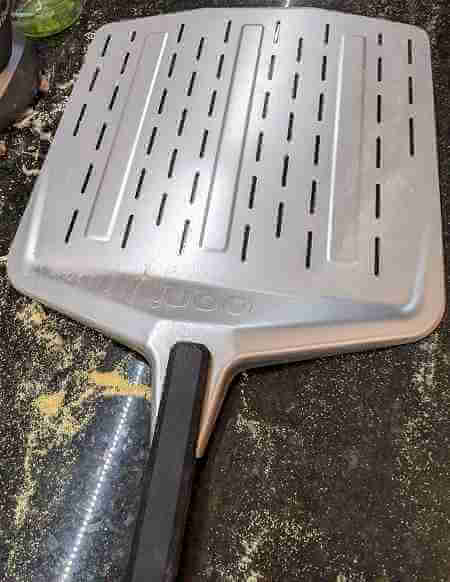
What Size Pizza Peel Do I Need?
After you decide the other factors, you’ll be asking what size pizza peel do I need. Most available peels are made perfectly for a 12-inch pizza and not a 16 inch. You can be a little undersized for getting a pizza out of the oven but not so much to transfer the pizza inside the oven. So, in deciding what size pizza peel do I need, the basic “formula” is to go with one that is 2 inches smaller than the size of your pizza stone.
As you may or may not have a stone (or pizza steel), I translate that to be you can get one that is 2 inches smaller than the biggest size pizza you anticipate making. For example, my pizza stone and pizza steel can handle a 16-inch pizza. So, I chose a 14-inch peel for the metal one. And, for the wooden peel, I chose a 16-inch size because that will be used for also cutting the slices of a 16-inch pizza so I don’t want the pizza sides hanging off for that.
What Is The Best Pizza Peel To Buy
In knowing what is the best pizza peel to buy, you can make your pizza making process so much easier and less stressful. The best pizza peels to buy are from several producers like Ooni, New Star Foodservice, and Exo. They are the best pizza peels for making pizza, calzone, breads, or other related dishes.
We did consider costing as well and did not include any $300 and higher options that generally are reserved for the commercial chefs. Keep reading about each of the best pizza peels, in our opinion, that you can have in your home kitchen.
We did look at some and felt that the ones we chose had the same benefits and are the most optimum for those cooking at home, whether you make these Italian cooked pies daily or monthly. We talk a bit about each of them and sometimes make reference to the pros and cons but most of those aspects have already been covered in the earlier part of this article when deciding on wood or metal peels.
Best Wooden Pizza Peel: New Star Wooden Pizza Peel
The best wooden pizza peel to buy is the New Star Foodservice Restaurant-Grade Wooden Pizza Peel. They have a lot of restaurant-grade items available that are for both commercial and home use. This item, in particular, is of a very good quality and has proven itself long term reliability by reviewers. You’ll want to get also a food grade oil for long term protection. Generally, you’ll want to get either a 14-inch or a 16-inch wooden peel for handling 14 to 16 inch pizzas.
Best Metal Pizza Peel: Ooni Perforated Peel
The best metal peel is the Ooni Perforated Peel and it comes in several sizes. I use the 14-inch wide by 16-inch long one, which works perfect for round 14-inch pizzas or larger rectangular16-inch long pizzas.
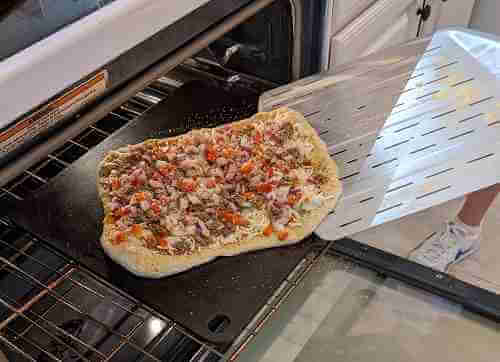
This aluminum peel is best for all transfers of pizza, especially for uncooked pizza dough. It has all the desired options in a metal pizza peel and is known for its super reviews for many of its products, and particularly for this item.
It can easily transfer an uncooked pizza onto the peel directly from the work surface as well as from the oven. Also, it doesn’t generally come with a wooden handle but this isn’t necessary as its handle will be insulated regardless. Here’s a link to the Ooni site for its “Pizza Peels” collections which include all their pizza peels and related items.
Best Pizza Peel for Beginners: EXO Super Peel Pro Composite
The best pizza peel for beginners is the EXO Non-Stick Super Peel Pro Composite.
EXO Non-Stick Super Peel Pro Composite
This type uses something like a conveyor belt and the base is made of a composite material so, cleaning is easy. It solves a problem that other peels might have on removal of the pizza from the countertop work surface. Also, it has a little video of its usage on the site. It is considered by some, however, to be problematic in changing it out between getting off the countertop vs getting it out of an oven.
Another consideration is that it does use moving parts, which the others do not. Moving parts are required to always work in order to function so, the durability of that is a consideration for long term usage and overall reliability. However, this is the best for people that are just starting out or for those who consider making pizzas about 6 times a year or so.
Best Pizza Peel Turner: Ooni Pizza Turning Peel (7-inch)
The best peel turner is the Ooni 7-inch Pizza Turning Peel. The Turning Pizza Peels are another specialized tool for pizza cooks who use a specialize oven, known as a pizza oven or a pizza fire oven. Those are the ones that can go to the higher temperatures over 500 degrees Fahrenheit. It’s not uncommon to be 800 degrees F or higher. The pizzas cook so fast, e.g., about 4 minutes, that they can very often cook unevenly.
So, the need for turning it once or twice during the cooking process justifies the need for a turning peel. These have medium to long handles with very small paddles. A normal size paddle would be about 7-9 inches. This particular turning pizza peel received healthy reviews in all areas, including for sturdiness.
There was a 2nd place contender for this. It was the Chef Pomodoro Aluminum 9-Inch Turning Pizza Peel with Detachable Wood Handle. While it was great for everything overall, it was sometimes worrisome on its sturdiness by a number of reviewers. This is a common issue with handles that are foldable or removable for easier storage. However, having a removable or sectioned handle is very popular in pizza turning peels so that might be an acceptance for many.
About Using Pizza Peels
Here are some commonly asked questions about pizza peels and choosing one.
Can you cut pizza on a pizza peel?
You can sometimes cut on a pizza peel; however, there are many exceptions. For example, never cut anything on a metal pizza peel. You can cut or slice on wooden peels only if they’re fairly thick and made of a good quality wood. Generally, the manufacturer will advise on this. There are composite pizza peels that often allow to cut or slice on them.
What is the best oil to use on a wooden pizza peel?
The best kind of pizza peel oil to use on a wooden pizza peel is a food grade mineral oil. It will ensure it has a longer life and no cracking. I’ve had the same wooden pizza peel for quite a few years and there are zero splits or cracks in it, thanks to the use of the food grade mineral oil.
Conclusion
In conclusion, when looking for the best pizza peels, it is important to consider the functions, surface, and material. Wood and metal peels are both great options, but each has their own functions and advantages.
Metal peels are lighter and easier to use, while wooden peels are more affordable but have a better grip. Wooden peels are thicker and can’t scoop up raw pizzas very well. However, you can slice pizzas directly on the thicker wooden peels. So, with many factors to consider, you’ve learned how to narrow down your choice based on your own needs and preferences. Also, you’ve learned some people choose to have one wooden and one metal peel. Tell me what your pizza peel plans are in the comments.
Related To Homemade Pizza Baking
- Best Pizza Peels by Purpose, Material, & Surface (this post)
- How To Use A Pizza Peel
- How To Make & Bake Pizza in Oven – Several Recipes
- How To Clean Pizza Steel
- Cast Iron Pizzas – Complete Guide
- Reheating Pizzas

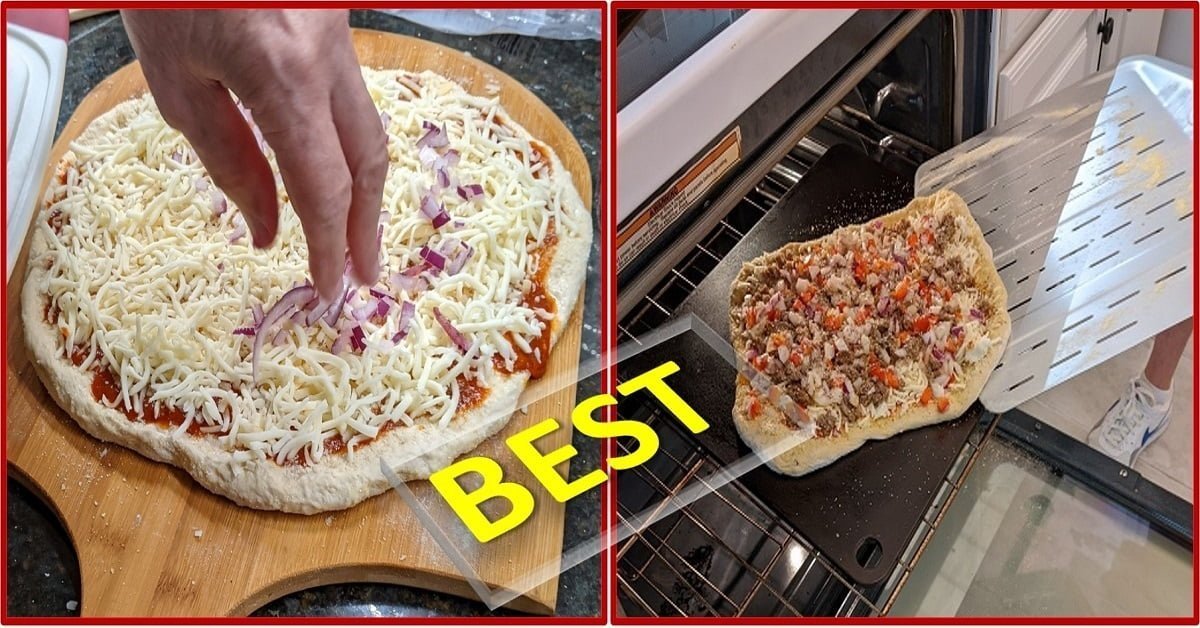
1 comment
Maves8723
I’ve recently started a website, the information you provide on your site has helped me tremendously. Thank you for all of your time & work.